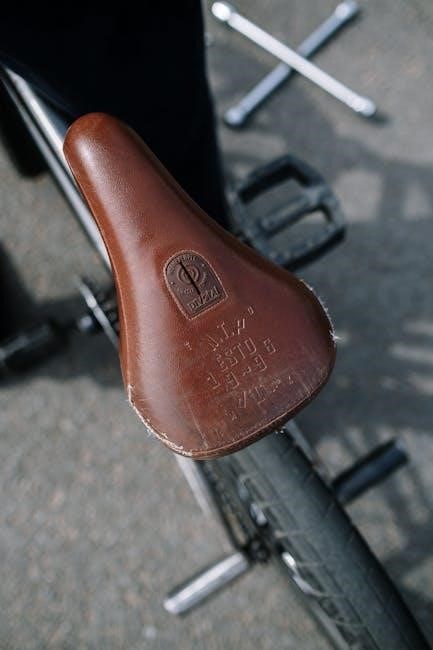Importance of Choosing the Right Tire Width
Choosing the right tire width is crucial for a safe and enjoyable biking experience. The correct tire width can improve the overall performance of the bike‚ providing better traction‚ control‚ and stability. A suitable tire width can also reduce the risk of accidents and injuries‚ as it allows for better handling and maneuverability. Additionally‚ the right tire width can enhance the comfort of the ride‚ absorbing bumps and shocks more effectively. Furthermore‚ selecting the correct tire width can also impact the bike’s efficiency‚ affecting the rolling resistance and speed. By considering the importance of choosing the right tire width‚ riders can optimize their bike’s performance and enjoy a more pleasant and secure riding experience. The internet provides various resources and guides to help riders determine the most suitable tire width for their bike‚ taking into account factors such as riding style‚ terrain‚ and personal preference.

Understanding Bike Tire Sizes
Bike tire sizes are measured in inches or millimeters‚ indicating the diameter and width of the tire‚ with various online charts and guides available to help understand the different sizes and measurements.
Tire Size Chart and Compatibility
A tire size chart is a useful tool for determining compatibility between tires and rims‚ providing a comprehensive list of tire sizes and their corresponding rim widths. The chart helps to ensure that the selected tire is compatible with the bike’s rim‚ preventing potential issues such as poor fit‚ reduced performance‚ and increased risk of punctures. By consulting a tire size chart‚ riders can make informed decisions when selecting tires‚ taking into account factors such as tire width‚ diameter‚ and rim width. Additionally‚ many online resources and manufacturer websites offer tire size charts and compatibility guides‚ making it easier for riders to find the right tires for their bikes. Using these resources‚ riders can optimize their bike’s performance‚ safety‚ and overall riding experience‚ and find the perfect tire and rim combination for their specific needs and preferences‚ every time they ride.

Factors to Consider When Choosing Tire Width
Considerations include rider weight‚ terrain‚ and bike type to determine optimal tire width for comfort and performance‚ using online guides and charts for reference and decision making purposes always.
Rim Width and Tire Size Relationship
The relationship between rim width and tire size is crucial in determining the optimal tire width for a bike. A wider rim can accommodate a wider tire‚ while a narrower rim is better suited for a narrower tire. This relationship is important because it affects the bike’s handling‚ stability‚ and overall performance. The width of the rim also affects the tire’s profile‚ with a wider rim allowing for a more rounded tire profile and a narrower rim resulting in a more squared-off profile. Additionally‚ the rim width and tire size combination can impact the bike’s rolling resistance‚ traction‚ and comfort. By understanding the relationship between rim width and tire size‚ riders can make informed decisions when choosing the optimal tire width for their bike. This knowledge can help riders optimize their bike’s performance‚ improve their riding experience‚ and reduce the risk of tire-related issues. The rim width and tire size relationship is a key consideration in the bike tire width guide.

Types of Bikes and Tire Widths
Various bike types require specific tire widths for optimal performance and comfort‚ including road‚ mountain‚ and hybrid bikes with unique tire width needs and requirements always.
Mountain Bikes and Wide Tire Options
Mountain bikes often feature wide tire options to provide increased traction and control on various terrain types‚ including rocky‚ muddy‚ and sandy trails. The wider tires on mountain bikes allow for better absorption of bumps and shocks‚ resulting in a smoother ride. Additionally‚ the wider tires provide increased stability and cornering ability‚ making them ideal for downhill and aggressive riding styles. Many mountain bike manufacturers offer a range of tire width options‚ from 2.2 to 2.5 inches‚ to cater to different riding preferences and terrain types; The wide tire options on mountain bikes also enable riders to run lower air pressures‚ which can improve traction and control. Overall‚ the wide tire options on mountain bikes play a crucial role in enhancing the riding experience and providing a competitive edge in various mountain biking disciplines. With the right tire width‚ mountain bikers can tackle challenging trails with confidence and precision.
Tire Width and Performance
Tire width affects bike performance‚ influencing speed‚ stability‚ and handling‚ with optimal widths varying depending on bike type and riding conditions‚ using online guides for selection.
Optimal Tire Width for Different Bikes
The optimal tire width for different bikes depends on various factors‚ including the type of bike‚ riding conditions‚ and personal preferences. For road bikes‚ a narrower tire width is often preferred for faster speeds and improved efficiency. In contrast‚ mountain bikes require wider tires for better traction and control on rugged terrain. Hybrid bikes‚ which combine elements of road and mountain bikes‚ may use tire widths that fall somewhere in between. Additionally‚ the width of the rim and the type of riding‚ such as commuting or racing‚ can also influence the optimal tire width. By considering these factors and consulting online resources‚ riders can determine the ideal tire width for their specific bike and riding style‚ ensuring a comfortable and enjoyable ride. This information is crucial for riders to make informed decisions when selecting tires for their bikes. Various online guides and charts are available to help riders determine the optimal tire width.

Common Issues with Incorrect Tire Width
Incorrect tire width causes problems‚ including poor stability and efficiency‚ using online guides helps prevent these issues‚ ensuring a safe ride always‚ with proper tire width‚ every time‚ for all bikes.
Pinch Flats‚ Blowouts‚ and Tire Burping
Pinch flats‚ blowouts‚ and tire burping are common issues associated with incorrect tire width‚ these problems can be prevented by choosing the right tire size‚ using a tire width chart to ensure compatibility with the rim‚ and maintaining proper tire pressure.
The WTB Tire and Rim Compatibility Chart is a useful resource for determining optimal tire and rim width combinations‚ by matching the tire section width to the rim width‚ cyclists can determine the best fitting options for their bike.
Additionally‚ understanding the relationship between rim width and tire size is crucial in preventing these issues‚ a rim that is too narrow for the tire can cause pinch flats and blowouts‚ while a rim that is too wide can lead to tire burping.
By considering these factors and using the right tools‚ cyclists can minimize the risk of these problems and ensure a safe and enjoyable ride.
Proper tire width and pressure can make a significant difference in the overall performance and safety of the bike‚ and cyclists should take the time to research and understand the best options for their specific bike and riding style.
and Recommendations
The key takeaways include understanding the importance of rim width and tire size compatibility‚ considering the type of bike and riding style‚ and using online resources such as the WTB Tire and Rim Compatibility Chart to determine the best fitting options.
By taking the time to research and understand the different factors that affect tire width‚ cyclists can minimize the risk of common issues such as pinch flats and blowouts‚ and ensure a safe and enjoyable ride.
Ultimately‚ the right tire width can make a significant difference in the overall performance and safety of the bike‚ and cyclists should prioritize this aspect of their bike’s setup.
By doing so‚ they can optimize their riding experience and get the most out of their bike‚ whether they are riding on the road‚ trail‚ or commute.


